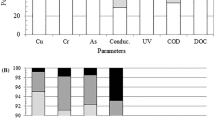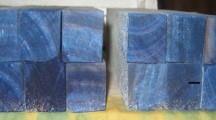Abstract
Chemical extraction, bioremediation, and electrodialytic processes have been extensively studied for removal of copper, chromium, and arsenic from wood treated with chromated copper arsenate (CCA). However, one problem has not been addressed: the effects of wood species and retention levels on remediation efficiency. The objectives of this study were to investigate the effects of wood species and retention levels on removal of copper, chromium, and arsenic from CCA-treated wood samples using sodium hypochlorite. Our results showed that sodium hypochlorite (NaOCl) was very effective for removal of copper, chromium, and arsenic from CCA-C treated milled wood samples for all three species used in this study. The Cu, Cr, and As extraction efficiencies for red pine were 95 % Cu, 97 % Cr and 94 % As, for maple were 95 % Cu, 97 % Cr, and 98 % As at 4.0 kg m−3 retention levels, and for aspen were 95 % Cu, 92 % Cr, and 91 % As at 9.6 kg m−3 retention level, respectively. However, the results showed that wood species and initial retention levels of CCA-treated wood products played very important roles in terms of removal of Cu, Cr, and As.


Similar content being viewed by others
References
AWPA (1999) Standard P5-97. Standards for waterborne preservatives. In: American Wood Preservers’ Association Book of Standards. AWPA, Granbury
AWPA (2006) AWPA Standard A7-93 Standard for wet ashing procedures for preparing wood for chemical analysis. Book of Standards. AWPA, Birmingham
Bull DC (2001) The chemistry of chromated copper arsenate II. Preservative–wood interactions. Wood Sci Technol 34:459–466
Choi YS, Kim JJ, Kim MJ, Son J, Kim GH (2013) Optimization of bioleaching conditions for metal removal from CCA-treated wood by using an unknown Polyporales sp. KUC8959. J Environ Manag 121:6–12
Clausen CA (2000) CCA removal from treated wood using a dual remediation process. Waste Manag Res 18:485–488
Clausen CA (2004) Improving the two-step remediation process for CCA-treated wood: Part II. Evaluating bacterial nutrient sources. Waste Manag 24:407–411
Clausen CA, Smith RL (1998) Removal of CCA from treated wood by oxalic acid extraction, steam explosion, and bacterial fermentation. J Ind Microbiol Biotechnol 20:251–257
Cooper PA (1993) Disposal of treated wood removed from service: the issues. In: Proceedings of environmental considerations in manufacture, use, and disposal of preservative treated wood. Madison: Carolinas-Chesapeake Section, Forest Products Society, pp. 85–90
Coudert L, Blais JF, Mercier G, Cooper P, Janin A, Gastonguay L (2014) Demonstration of the efficiency and robustness of an acid leaching process to remove metals from various CCA-treated wood samples. J Environ Manag 132:197–206. doi:10.1016/j.jenvman.2013.11.028
De Groot RC, Woodward B (1998) Wolfiporia cocos—a potential agent for composting or bioprocessing Douglas-fir wood treated with copper-based preservatives. Materialen und Organismen 32:195–215
Gezer ED, Cooper PA (2009) Factors affecting sodium hypochlorite extraction of CCA from wood. Waste Manag 29(2009):3009–3013
Helsen L, Van den Bulck E (2005) Review of disposal technologies for chromated copper arsenate (CCA) treated wood waste with detailed analysis of thermo-chemical conversion processes. Environ Pollut 134:301–314
Helsen L, Bulck EVD, Hery JS (1998) Total recycling of CCA treated wood waste by low-temperature pyrolysis. Waste Manag 18:571–578
Huang C, Cooper PA (2000) Cement-bonded particleboards using CCA-treated wood removed from service. For Prod Soc 50:49–56
Humar M, Pohleven F, Sentjurc M (2004) Effect of oxalic, acetic acid, and ammonia on leaching of Cr and Cu from preserved wood. Wood Sci Technol 37(2004):463–473
Jorge FC, Santos TM, de Jesus JP, Banks WB (1999a) Reactions between Cr(VI) and wood and its model compounds. Part 1: a qualitative kinetic study of the reduction of hexavalent chromium. Wood Sci Technol 33:487–499
Jorge FC, Santos TM, de Jesus JP, Banks WB (1999b) Reactions between Cr(VI) and wood and its model compounds. Part 2: characterisation of the reaction products by elemental analysis, magnetic susceptibility and FTIR. Wood Sci Technol 33:501–517
Kakitani T, Hata T, Kajimoto T, Imamura Y (2006) Designing a purification process for chromium-, copper- and arsenic-contaminated wood. Waste Manag. 26:453–458
Kakitani T, Hata T, Kajimoto T, Koyanaka H, Imamura Y (2009) Characteristics of a bioxalate chelating extraction process for removal of chromium, copper and arsenic from treated wood. J Environ Manag 90:1918–1923
Kartal SN, Clausen CA (2001) Leachability and decay resistance of particleboard made from acid extracted and bioremediated CCA-treated wood. Int Biodeterior Biodegrad 47:183–191
Kartal SN, Kakitani T, Imamura Y (2004a) Bioremediation of CCA-C treated wood by Aspergillus niger fermentation. Holz als Roh- und Werkstoff 62:64–68
Kartal SN, Munir E, Kakitani T, Imamura Y (2004b) Bioremediation of CCA treated wood by brown-rot fungi Fomitopsis palustris, Coniophora puteana, and Laetiporus sulphureus. J Wood Sci 50:182–188
Kartal SN, Katsumata N, Imamura Y (2006) Removal of copper, chromium, and arsenic from CCA-treated wood by organic acids released by mold and staining fungi. For Prod J 56:33–37
Kazi FKM, Cooper PA (1998) Solvent extraction of CCA-C from out-of-service wood. International research group on wood protection. Document IRG/WP 98-50107
Kim GH, Choi YS, Kim JJ (2009) Improving the efficiency of metal removal from CCA-treated wood using brown rot fungi. Environ Technol 30:673–679
Lebow S, Cooper PA, Lebow P (2004) Variability in evaluating environmental impacts of treated wood. In: Proceedings of environmental impacts of preservative-treated wood, 8–11 Feb 2004, Orlando
Lin L, Hse C (2002) Removal of CCA from spent CCA-treated wood. The international research group on wood preservation, 33rd annual meeting in Cardiff, IRG/WP 02-50192
McMahon V, Garg A, Aldred D, Hobbs G, Smith R, Tothill IE (2009) Evaluation of the potential of applying composting/bioremediation techniques to wastes generated within the construction industry. Waste Manag 29:186–196
Nico PS, Fendorf SE, Lowney YW, Holm SE, Ruby MV (2004) Chemical structure of arsenic and chromium in CCA-treated wood: implications of environmental weathering. Environ Sci Technol 38:5253–5260
Pizzi A (1981) The chemistry and kinetic behavior of Cu–Cr–As/B wood preservatives. I. Fixation of chromium on wood. J Polym Sci 19:3093–3121
Pizzi A (1982) The chemistry and kinetic behavior of Cu–Cr–As/B wood preservatives. IV. Fixation of CCA to wood. J Polym Sci 20:739–764
Preston A, Jin H (2008) Trends in wood protection in Asia and Oceania: a perspective. April 2, 2008, 599–607. In: Schultz T et al. (eds), Development of commercial wood preservatives; ACS symposium series; American chemical society: Washington, DC
Radivojevic S (2006) Investigation of formation and stability of fixation products of inorganic wood preservatives based on their differential solubilities in aqueous solutions. Ph.D. Thesis, Faculty of Forestry, University of Toronto, Toronto
Radivojevic S, Cooper PA (2007) Effects of CCA-C preservative retention and wood species on fixation and leaching of Cr, Cu, and As. Wood Fiber Sci 39:591–602
Radivojevic S, Cooper PA (2010) The effects of wood species and treatment retention on kinetics of CCA-C fixation reactions. Wood Sci Technol 44:269–282
Shupe TF (2002) Closed loop recycling of preservative treated wood. At: recent developments in the wood preservation industry. Forest products society midsouth section annual meeting, Biloxi, 17 Oct 2002
Shupe TF, Hse CY (2006) Recycling of preservative-treated wood using chemical extraction technologies. In: Townsend T, Solo-Gabriele H (eds) Environment impact of preservative-treated wood. CRC Press, Boca Raton, pp 383–400
Shupe TF, Piao C, Pan H (2008) Update on closed loop preservative treated wood recycling program. In: AWPA annual meeting. Portland, 18–20 May 2008
Sierra-Alvarez R (2009) Removal of copper, chromium and arsenic from preservative-treated wood by chemical extraction-fungal bioleaching. Waste Manag 29:1885–1891
Stephan I, Leithoff H, Peek RD (1996) Microbial conversion of wood treated with salt preservatives. Material und Organismen 30:179–199
Tame NW, Dlugogorski BZ, Kennedy EM (2007) Formation of dioxins and furans during combustion of treated wood. Prog Energy Combust Sci 33(4):384–408
Townsend T, Thabet T, Solo-Gabriele H, Dubey B, Stook K, Wadanambi L (2004) Leaching of CCA-treated wood: implications for waste disposal. J Hazard Mater B114:75–91
US Environmental Protection Agency (2002) Notice of receipt of requests to cancel certain chromated copper arsenate (CCA) wood preservative products and amend to terminate certain uses of CCA products. Federal Register, 22 Feb 2002 67(36): 8244–8246
Velizarova E, Ribeiro AB, Ottosen LM (2002) A comparative study on Cu, Cr and As removal from CCA-treated wood waste by dialytic and electrodialytic processes. J Hazard Mater B94(2002):147–160
Waldron L, Cooper PA, Ung TY (2005) Prediction of long-term leaching potential of preservative-treated wood by diffusion modeling. Holzforsch 59(5):581–588
Wu Q, Yao F, Ragon K, Curole J, Votiller M, Shupe T (2010) Extruded wood plastic composites based on ACQ and MCQ-treated wood materials. IRG/WP 10-40495
Acknowledgements
The authors would like to thank Dr. Suzana Radivojevic for her help and for wood samples impregnation/preparation. The authors also would like to thank Tony Ung for his help with ICP analysis.
Author information
Authors and Affiliations
Corresponding author
Additional information
The online version is available at http://www.springerlink.com
Corresponding editor: Yu Lei
Rights and permissions
About this article
Cite this article
Gezer, E.D., Cooper, P.A. Effects of wood species and retention levels on removal of copper, chromium, and arsenic from CCA-treated wood using sodium hypochlorite. J. For. Res. 27, 433–442 (2016). https://doi.org/10.1007/s11676-015-0172-3
Received:
Accepted:
Published:
Issue Date:
DOI: https://doi.org/10.1007/s11676-015-0172-3




